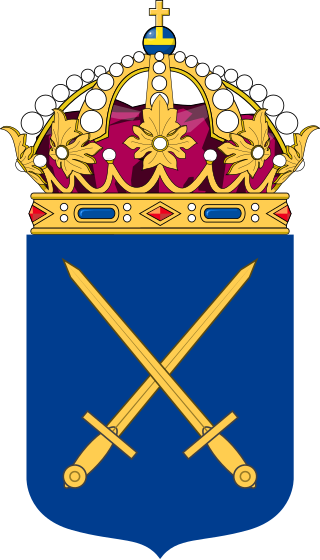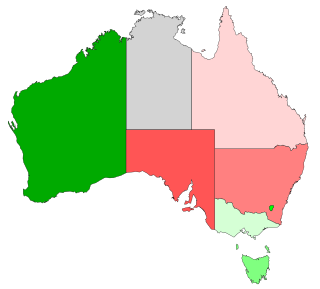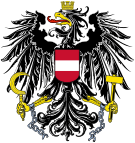
Conscription is the state-mandated enlistment of people in a national service, mainly a military service. Conscription dates back to antiquity and it continues in some countries to the present day under various names. The modern system of near-universal national conscription for young men dates to the French Revolution in the 1790s, where it became the basis of a very large and powerful military. Most European nations later copied the system in peacetime, so that men at a certain age would serve 1 to 8 years on active duty and then transfer to the reserve force.

The Swedish Armed Forces are the armed forces of the Kingdom of Sweden, tasked with the defence of the country as well as with promoting Sweden's wider interests, supporting international peacekeeping, and providing humanitarian aid. It consists of four service branches: the Swedish Army, the Swedish Air Force and the Swedish Navy, as well as a military reserve force, the Home Guard. Since 1994, all Swedish military branches are organised within a single unified government agency, the Swedish Armed Forces Headquarters, which is headed by the Supreme Commander, even though the individual services maintain their distinct identities.
The Swiss Armed Forces operates on land and in the air, serving as the primary armed forces of Switzerland. Under the country's militia system, regular soldiers constitute a small part of the military and the rest are conscripts or volunteers aged 19 to 34. Because of Switzerland's long history of neutrality, the Swiss Armed Forces do not take part in conflicts in other countries, but do participate in international peacekeeping missions. Switzerland is part of the NATO Partnership for Peace programme.

The Bundeswehr is the armed forces of the Federal Republic of Germany. The Bundeswehr is divided into a military part and a civil part, the military part consisting of the German Army, the German Navy, the German Air Force, the Joint Support Service, the Joint Medical Service, and the Cyber and Information Domain Service.

The Swedish Army is the land force of the Swedish Armed Forces. The army's history dates back to the Swedish War of Liberation in 1521.

Conscription in Australia, also known as National Service following the Second World War, has a controversial history which dates back to the implementation of compulsory military training and service in the first years of Australia's nationhood. Military conscription for peacetime service was abolished in 1972.

Military service is service by an individual or group in an army or other militia, air forces, and naval forces, whether as a chosen job (volunteer) or as a result of an involuntary draft (conscription).

The Federal Republic of Germany had conscription for male citizens between 1956 and 2011. On 22 November 2010, the German Minister of Defence proposed to the government to put conscription into abeyance on 1 July 2011. The constitution, however, retains provisions that would legalize the potential reintroduction of conscription.

The 1916 Australian referendum, concerning how conscripted soldiers could be deployed, was held on 28 October 1916. It was the first non-binding Australian referendum, and contained one proposition, which was Prime Minister Billy Hughes' proposal to allow conscripted troops to serve overseas during World War I.
The Constitution Alteration Bill 1946, was a successful proposal to alter the Australian Constitution to give the Commonwealth power over a range of social services. The question was put to a referendum in the 1946 Australian referendum with two other (unrelated) questions. It was carried and inserted into section 51 of the Australian Constitution.

A reservist is a person who is a member of a military reserve force. They are otherwise civilians, and in peacetime have careers outside the military. Reservists usually go for training on an annual basis to refresh their skills. This person is usually a former active-duty member of the armed forces, and they remain a reservist either voluntarily, or by obligation. In some countries such as Israel, Norway, Finland, Singapore, and Switzerland, reservists are conscripted soldiers who are called up for training and service when necessary.

Taiwan, officially the Republic of China (ROC), maintains an active conscription system in accordance with the regulations set by the government of the Republic of China. All qualified male citizens of military age in the country are obligated to perform 1 year on active duty military service or receive 4 months of military training.

In Turkey, compulsory military service applies to all male citizens from 21 to 41 years of age. It is 6 months for all males regardless of education degree. Different rules apply to Turks abroad. For Turks with multiple citizenship, the conscription lapses if they have already served in the army of another country.

Conscription in Russia is a 12-month draft, which is mandatory for all male citizens who are between 18 and 30 years old, with a number of exceptions. Avoiding the draft is a felony under Russian criminal code and is punishable by up to 18 months of imprisonment. Conscripts are generally prohibited from being deployed abroad.
A regular army is the official army of a state or country, contrasting with irregular forces, such as volunteer irregular militias, private armies, mercenaries, etc. A regular army usually has the following:

In the United Kingdom, military conscription has existed for two periods in modern times. The first was from 1916 to 1920, and the second from 1939 to 1960. The last conscripted soldiers left the service in 1963.

Civil conscription is the obligation of civilians to perform mandatory labour for the government. This kind of work has to correspond with the exceptions in international agreements, otherwise it could fall under the category of unfree labour. There are two basic kinds of civil conscriptions. On the one hand, a compulsory service can be ordered on a temporary basis during wartimes and other times of emergency, like severe economic crisis or extraordinary natural events to provide basic services to the population. These include, but are not limited to, medical care, food supplies, defense industry supplies or cleanup efforts, following a severe weather or environmental disaster for the duration of the emergency. Therefore, it generally makes striking illegal for the duration of the civil mobilization. On the other hand, a revolving mandatory service may be required for a longer period of time, for example, to ensure community fire protection or to carry out infrastructure work at a local or community level.

Switzerland has mandatory military service in the Swiss Army for all able-bodied male citizens, who are conscripted when they reach the age of majority. Women may volunteer for any position. Conscripts make up the majority of the manpower in the Swiss Armed Forces.

Conscription in Egypt is a form of a compulsory military service in Egypt.
During the second half of World War I, the First Australian Imperial Force experienced a shortage of men as the number of men volunteering to fight overseas declined and the casualty rate increased. At the time, military service within the Commonwealth of Australia and its territories was compulsory for Australian men, but that requirement did not extend to conflict outside of Australia. In 1916, Prime Minister Billy Hughes called a plebiscite to determine public support for extending conscription to include military service outside the Commonwealth for the duration of the war. The referendum, held on 28 October 1916, narrowly rejected the proposal. A second plebiscite, held a year later on 20 December 1917, also failed to gain a majority.











